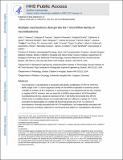Multiple mechanisms disrupt the let-7 microRNA family in neuroblastoma
Author(s)
Powers, John T.; Tsanov, Kaloyan M.; Pearson, Daniel S.; Roels, Frederik; Spina, Catherine S.; Ebright, Richard; Seligson, Marc; de Soysa, Yvanka; Cahan, Patrick; Theißen, Jessica; Tu, Ho-Chou; Han, Areum; Kurek, Kyle C.; LaPier, Grace S.; Osborne, Jihan K.; Ross, Samantha J.; Cesana, Marcella; Collins, James J.; Berthold, Frank; Daley, George Q.; ... Show more Show less
DownloadCollins_Multiple mechanisms.pdf (3.858Mb)
PUBLISHER_POLICY
Publisher Policy
Article is made available in accordance with the publisher's policy and may be subject to US copyright law. Please refer to the publisher's site for terms of use.
Terms of use
Metadata
Show full item recordAbstract
Poor prognosis in neuroblastoma is associated with genetic amplification of MYCN. MYCN is itself a target of let-7, a tumour suppressor family of microRNAs implicated in numerous cancers. LIN28B, an inhibitor of let-7 biogenesis, is overexpressed in neuroblastoma and has been reported to regulate MYCN. Here we show, however, that LIN28B is dispensable in MYCN-amplified neuroblastoma cell lines, despite de-repression of let-7. We further demonstrate that MYCN messenger RNA levels in amplified disease are exceptionally high and sufficient to sponge let-7, which reconciles the dispensability of LIN28B. We found that genetic loss of let-7 is common in neuroblastoma, inversely associated with MYCN amplification, and independently associated with poor outcomes, providing a rationale for chromosomal loss patterns in neuroblastoma. We propose that let-7 disruption by LIN28B, MYCN sponging, or genetic loss is a unifying mechanism of neuroblastoma development with broad implications for cancer pathogenesis.
Date issued
2016-07Department
Massachusetts Institute of Technology. Department of Biological EngineeringJournal
Nature
Publisher
Nature Publishing Group
Citation
Powers, John T., Kaloyan M. Tsanov, Daniel S. Pearson, Frederik Roels, Catherine S. Spina, Richard Ebright, Marc Seligson, et al. “Multiple Mechanisms Disrupt the Let-7 microRNA Family in Neuroblastoma.” Nature 535, no. 7611 (July 6, 2016): 246–251. © 2016 Rights Managed by Nature Publishing Group
Version: Author's final manuscript
ISSN
0028-0836
1476-4687